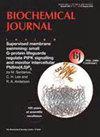Cas11 augments Cascade functions in type I-E CRISPR system but is redundant for gene silencing and plasmid interference.
IF 4.3
3区 生物学
Q2 BIOCHEMISTRY & MOLECULAR BIOLOGY
引用次数: 0
Abstract
The structural and mechanistic complexity of Escherichia coli's type I CRISPR-Cas system compared to the multidomain, single effector protein-based type II systems, limits its application in genome editing and silencing. Despite higher prevalence of the type I endogenous systems in bacteria, significant research has focused on improving the type II systems. While the type-I CRISPR system possesses several advantages over others, it may benefit from further studies to simplify the system for ease of use. To enable this, the dispensability of the type-I Cascade components (Cas8, Cas11, Cas7, Cas5, Cas6) for genome editing and silencing applications was evaluated in vivo. We created deletion variants of each of the Cascade components and investigated their effects on gene silencing and plasmid interference in two genetically distinct Escherichia coli lineages, BW25113, a K-12 strain that bears an endogenous, albeit repressed type I-E CRISPR system and BL21, a natural mutant lacking the type I-E CRISPR-Cascade system. Cas8, Cas7 and Cas5 were found to be indispensable for gene silencing and plasmid interference. Dispensability of Cas6, which is involved in crRNA maturation, was strain-dependent. Notably, Cas11 which has no definitive function assigned to it, was found to be dispensable for gene silencing and plasmid interference.Cas11增强了I-E型CRISPR系统中的Cascade功能,但在基因沉默和质粒干扰中是多余的。
与基于多结构域、单效应蛋白的II型CRISPR-Cas系统相比,大肠杆菌I型CRISPR-Cas系统的结构和机制复杂性限制了其在基因组编辑和沉默中的应用。尽管细菌中I型内源性系统的患病率较高,但重要的研究集中在改善II型系统上。虽然i型CRISPR系统比其他系统具有一些优势,但它可能受益于进一步的研究,以简化系统以便于使用。为了实现这一点,我们在体内评估了i型Cascade组件(Cas8、Cas11、Cas7、Cas5、Cas6)在基因组编辑和沉默应用中的可缺性。我们创建了每个Cascade组件的缺失变体,并研究了它们对两个遗传上不同的大肠杆菌谱系的基因沉默和质粒干扰的影响,BW25113是一种携带内源性的,尽管被抑制的I-E型CRISPR系统的K-12菌株,BL21是一种缺乏I-E型CRISPR-Cascade系统的自然突变体。发现Cas8、Cas7和Cas5在基因沉默和质粒干扰中不可或缺。参与crRNA成熟的Cas6的可缺性是菌株依赖性的。值得注意的是,Cas11没有明确的功能,被发现在基因沉默和质粒干扰中是必不可少的。
本文章由计算机程序翻译,如有差异,请以英文原文为准。
求助全文
约1分钟内获得全文
求助全文
来源期刊

Biochemical Journal
生物-生化与分子生物学
CiteScore
8.00
自引率
0.00%
发文量
255
审稿时长
1 months
期刊介绍:
Exploring the molecular mechanisms that underpin key biological processes, the Biochemical Journal is a leading bioscience journal publishing high-impact scientific research papers and reviews on the latest advances and new mechanistic concepts in the fields of biochemistry, cellular biosciences and molecular biology.
The Journal and its Editorial Board are committed to publishing work that provides a significant advance to current understanding or mechanistic insights; studies that go beyond observational work using in vitro and/or in vivo approaches are welcomed.
Painless publishing:
All papers undergo a rigorous peer review process; however, the Editorial Board is committed to ensuring that, if revisions are recommended, extra experiments not necessary to the paper will not be asked for.
Areas covered in the journal include:
Cell biology
Chemical biology
Energy processes
Gene expression and regulation
Mechanisms of disease
Metabolism
Molecular structure and function
Plant biology
Signalling
 求助内容:
求助内容: 应助结果提醒方式:
应助结果提醒方式:


